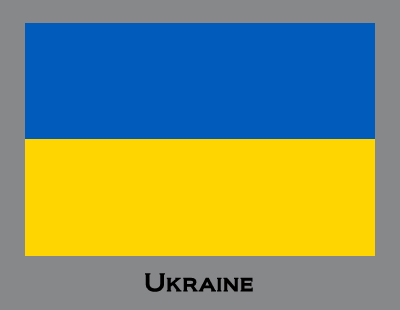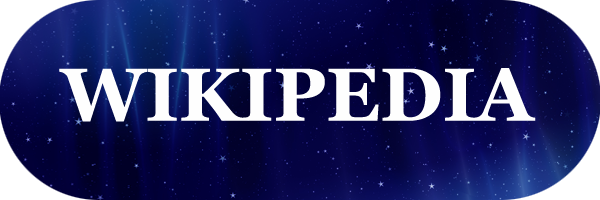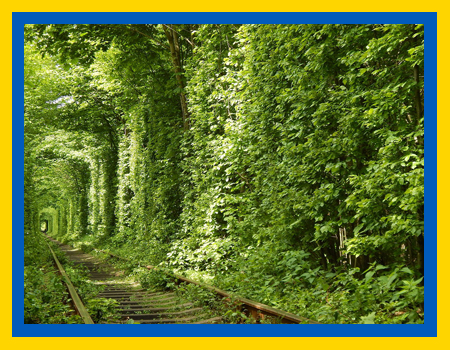|
UKRAINE
Ukraine is the largest country in Eastern Europe, excluding Russia. It is slightly smaller than Texas, USA and is approximately 20 times larger than Belgium.
The total land area is 233,090 square miles (603,700 square kilometres) and the country borders the Black Sea. The Black Sea is a massive lake without a tide, and its water level never changes. Ukraine's terrain is mostly flat plains and plateaus, with forested mountains to the west and far south.
Ukraine was the land for Trypillian Civilization, one of the world's most ancient civilizations. Neolithic archeological culture existed between 5500 BC and 2750 BC on the territory of modern Ukraine.
Ukraine was at the center of the first eastern Slavic state, Kyivan Rus, which in the 10th and 11th centuries was the largest and most powerful state in Europe. Ukraine shares borders with seven countries: Russia, Belarus, Poland, Slovakia, Hungary, Romania, and Moldova.
Ukraine's history is intertwined with Russia's history. The first Russian state, the Kievan Rus (9th-13th centuries AD), headed by the Rurik dynasty, was centered in Kiev, the capital of modern Ukraine.
Ukraine has endured serious political and economic strife. The Russian military intervention in Ukraine, sometimes called the Russo-Ukrainian War, is a prolonged armed conflict between Russia and Ukraine that began in February 2014. The war focuses on the status of the Ukrainian regions of the Crimean peninsula, the Donbas region of Eastern Ukraine, and other locations.
The International Republican Institute took a poll of the Ukrainian public, excluding Russian-annexed Crimea, in September 2014. They found that 89 percent of those polled opposed the 2014 Russian military intervention in Ukraine.
In 2017, Ukraine opened a case against Russia for involvement and financing of terrorism and racial discrimination in military occupied Autonomous Republic of Crimea and part of Donbas.
On December 29, 2019, Ukraine and Russia began swapping prisoners of war, in an attempt to restore peace and possibly end the war. Approximately 200 prisoners were exchanged.
2020 brought some hope for peace, until COVID-19. Ukraine had strict quarantine measures, stopped public transportation, and closed its borders, schools, and non-essential businesses, but COVID-19 hit the country hard, mainly because they have an underfunded national health system. Before COVID-19, more than three million Ukrainians needed humanitarian assistance in 2020.
Some people now hope the COVID-19 pandemic and the economic crisis will lead to ending the war. Russian COVID-19 cases have surged, and the country faces a recession. Other people believe that Russia will be able to endure the economic crisis.
Ukraine's population was approximately 44 million in July 2018. More than half the population is ethnic Ukrainians. The other ethnic groups include Russians, Belarusians, Moldovans, Crimean Tatars, Bulgarians, Hungarians, Romanians, Jews, Armenians, Poles, Greeks, and Tatars.
The official language is Ukrainian, the dominant language spoken in western and central cities, and many rural areas. Most native Ukrainians speak Russian as their second language. In eastern and southern cities Russian is the most spoken language.
Orthodox Christianity is the dominant religion. They have Greek Catholicism, which is more popular then Roman Catholicism. Other Christian denominations include Protestantism. There are small communities of Calvinists, Jehovah's Witnesses, Lutherans, Methodists, Seventh-Day Adventists, and the Church of Jesus Christ of Latter-Day Saints. Judaism and Islam are also practiced. They also have Buddhism and paganism - the belief of pre-Christian Slavs. Ukraine has one of the highest levels of religious freedom and religious diversity in Europe.
Kiev is the capital and the largest city of Ukraine. Kiev is the industrial, scientific, educational, and cultural center of Eastern Europe.
Ukraine has several high-tech industries, approximately 150 colleges and universities, 80 research institutes, and world famous historical landmarks.
The National University of Ostroh Academy, founded in 1576, is the first university in Eastern Europe.
Ukraine is the fourth educated nation in the world with 99.4 percent literacy. 70 percent of adult Ukrainians have secondary or higher education. Only North Korea has such high literacy rates.
Ukrainian Petr Prokopovich invented the frame bee hive (cozy bee houses) in 1814. Ukraine is one of the three world leaders in the production of honey.
Playwright, short story writer, and novelist Nikolai Gogol (1809-1852) was born in the Ukrainian Cossack town of Sorochyntsi, in the Poltava Governorate of the Russian Empire. Gogol was an acclaimed author.
Ilya Yefimovich Repin (1844-1930) was a renowned artist of the 19th century. He was born in Chuhuiv, Ukraine.
Józef Teodor Konrad Korzeniowski (Joseph Conrad) was a novelist, short story writer, and essayist (1857-1924) born in Berdychiv, Ukraine, then part of the Russian Empire; the region had once been part of the Crown of the Kingdom of Poland.
|















